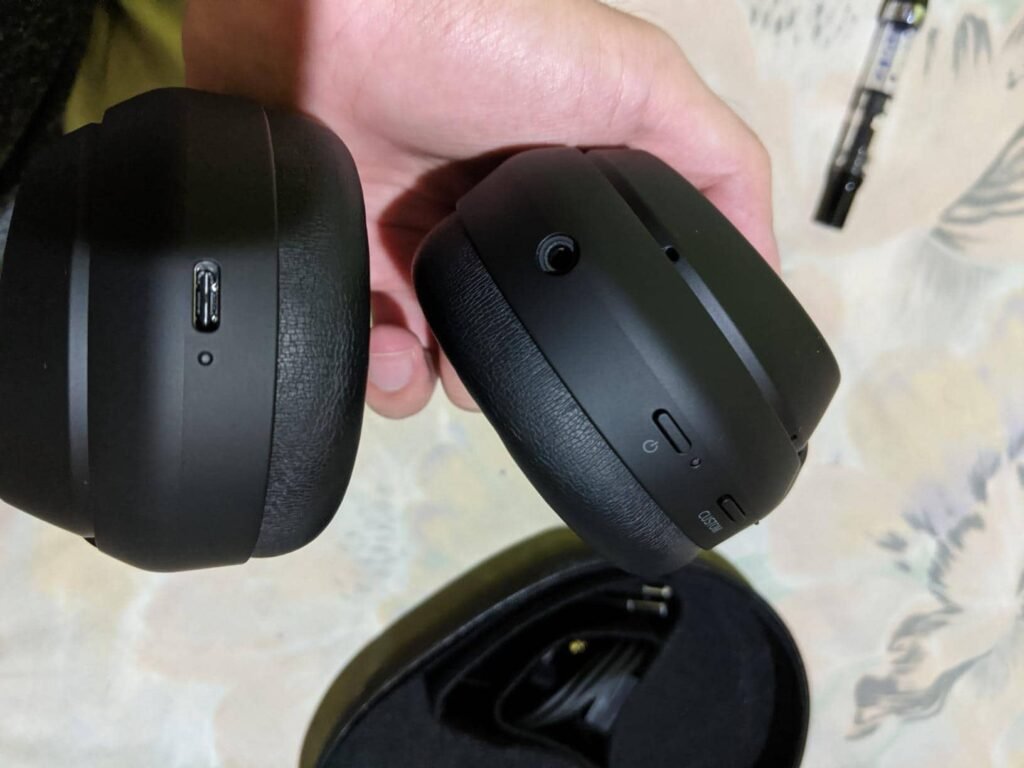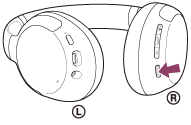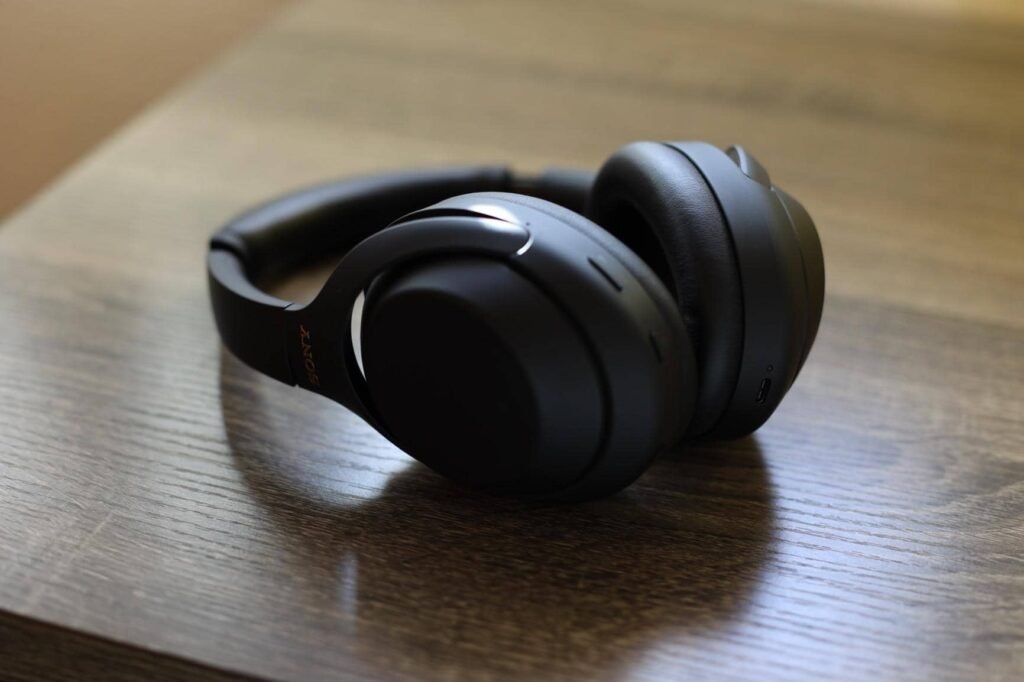On Sony headphones, the NC/AMB button is one of those things you start using without really thinking about it, depending on where you are and what you are doing at the moment. It lets you switch between noise cancelling and ambient sound, and NC stands for Noise Cancelling, while AMB means Ambient Sound.
Pressing the button cycles through three modes: Noise Cancelling, Ambient, and Off. In everyday use, it ends up being more useful than it looks at first, even though it sounds simple.
When I tested this on the WH-1000XM4, each press of the NC/AMB button gave a small voice prompt. You hear “Noise cancelling,” “Ambient sound,” or “Ambient sound control off,” and it took me a few tries to get used to the sequence. Once I did, switching became second nature.
In public, I usually left it on noise cancelling, then switched to ambient when walking near traffic.
Some older Sony models label the button differently, but the function stays the same. It gives you control over how much of the outside world gets in, or stays out.
What Does NC/AMB Mean on Sony Headphones?
With modern headphones offering more listening modes than ever, the NC/AMB label on Sony headphones usually catches your attention while you’re actually using them. The outside world suddenly feels quieter, or just as easily, a bit more present again with a single press.
In simple terms, the NC/AMB meaning on Sony headphones refers to switching between noise cancelling and ambient sound. It allows you either to mute what’s happening around you or to let some of it back in when staying aware makes more sense, whether you’re walking through a busy street, sitting at home, or moving between the two.
Rather than being a feature you need to think about, NC/AMB becomes part of everyday listening once you start using it. Questions like what does NC/AMB mean or what is NC/AMB usually come from real use, not from reading about it beforehand.
How to Use the NC/AMB Button
Using the NC/AMB button is simple. One press changes the mode, and the change is confirmed with a voice prompt. Press once for ANC. Press again for Ambient. Press again to turn both off.
After a bit of use, this becomes something you do without looking or thinking about it.
I tried this across different Sony models. On earbuds, the change felt almost instant. On larger headphones, it took about a second for the voice to confirm the switch.

Ambient sound felt a bit stronger on the bigger models, likely because of the way the microphones are positioned.
In louder spaces, I had to lower playback volume to hear ambient sounds clearly, especially on the WF series. Even then, the switching itself worked reliably, without delay or missed inputs.
What Is Active Noise Cancelling (ANC)?
Sony’s ANC uses microphones to pick up ssurrounding noise, then plays an opposite signal to cancel it out. I tested this in a shared office space and during a short flight.
In both cases, low-frequency sounds like fan noise and engine rumble dropped noticeably.
The effect was strongest in constant noise environments. While typing on a mechanical keyboard, the sound did not disappear, but it felt more distant.
It is not perfect silence, but it is enough to make a difference in focus.
When ANC was active with no music playing, some models added a low hiss. It was not loud, but it was there. On newer models, this was much less noticeable.
What Is Ambient Sound Mode (AMB)?
Ambient Sound Mode works the other way around. Instead of blocking noise, it lets some of it through. The headphones use external microphones to capture what is going on around you and blend it into the audio.

This was useful while walking through a busy area. I could hear announcements at the station and traffic approaching behind me without taking the headphones off. On the WF-1000XM4, I used this mode during a grocery run and had no trouble hearing the cashier while music was playing.
There is also a Focus on Voice setting. When using ambient mode indoors, background hum dropped and nearby voices became easier to hear. It worked well for short conversations without pausing the audio.
Switching between Noise Cancelling and Ambient feels like changing how you experience your surroundings. One mode blocks things out, the other keeps you aware of what is happening around you.
NC vs Ambient Mode
With modern life being more frenetic – and noisy – than ever, active noise-cancelling technology can mute the outside world, while Transparency, sometimes called Ambient or Aware mode, lets sound in if you want to briefly hear your surroundings.
By muting the outside world, ANC headphones allow you to zero in and focus on a task in near silence, while Ambient mode is handy for hearing oncoming cars, train announcements, or chatting without removing your headphones. When you need to be back in the room, you can simply toggle the ANC off and put the Transparency mode on, letting surrounding voices and environmental noise back in while still listening to your music.
Is NC the Same as ANC on Sony Headphones?
Active noise-cancelling technology is explained as a feature that actively listens to the noise around you and creates an opposite sound wave to cancel it out, and this same technology is used in wireless ANC headphones such as the Sony WF-1000XM5 and Sony WH-1000XM5.
By muting the outside world, these headphones let you hear your music uninterrupted or allow you to zero in and focus on a task in near silence. When toggled on, the technology listens to surrounding noise, processes it, and produces the appropriate sound to reduce external noise, which is the same active noise-cancelling function described throughout.
Customizing NC/AMB Function in App
Once you open the Sony Headphones Connect app, it becomes clear that noise cancelling and ambient sound aren’t meant to be used the same way by everyone. Instead of being locked into a single setting, you’re given control over how strong each mode feels, which makes a bigger difference than you might expect.

After some time using the headphones, you start to realize that full noise cancelling isn’t always what you want. Sometimes it feels a bit too isolating, and dialing it back slightly just feels more natural. The same goes for ambient sound, where letting in just enough outside noise can be more comfortable than hearing everything at once.
User Insights and Reddit Feedback
If you have been paying attention up ’til now, you will know that noise-cancelling headphones are a great option for travel and noisy environments, while Transparency mode lets surrounding voices and environmental noise back in. Users note how easy it is to switch modes depending on the situation, whether listening in peace or staying aware of what is happening around them, without removing the headphones.
Is Noise Cancelling and Ambient Mode Useful for Gamers

For gamers, the value of noise cancelling and ambient sound depends a lot on the environment they’re playing in. Noise cancelling can help reduce distractions and keep you immersed during longer sessions where background noise can become tiring.
Ambient mode makes sense in situations where you don’t want to be completely cut off from what’s happening around you. Being able to hear someone talk to you or notice sounds in the room without taking the headphones off adds a layer of comfort. While these features won’t change how a game sounds, they can change how comfortable it is to play for hours at a time.
FAQs on NC/AMB on Sony Headphones
What is the main difference between noise cancelling and ambient mode?
Noise cancelling blocks outside noise, while ambient mode lets some of it through so you can hear what’s around you.
Do I need to use the app to switch between NC and ambient mode?
You don’t have to, but the app makes it easier to adjust how strong each mode feels.
Is noise cancelling always better than ambient mode?
No, it depends on where you are and whether you want to block sounds out or still hear them.
Does ambient mode affect sound quality?
Ambient mode doesn’t change the sound itself, but outside noise can be heard along with your audio.
Are noise cancelling and ambient mode useful for gaming?
They can be useful depending on your environment, but they don’t change how the game itself sounds.